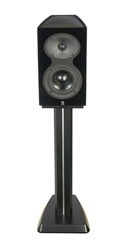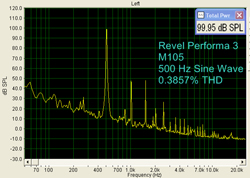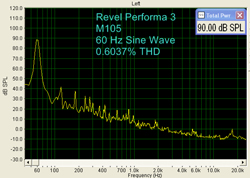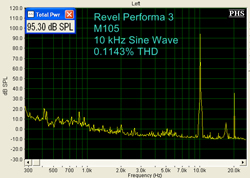Introduction to the Revel Performa 3 M105 Bookshelf Speakers
Revel has just released the third generation of their Performa speaker line. Dubbed the Performa3’s, the new lineup offers nine models – two tower speakers, two bookshelf speakers, two center speakers, two subs and one surround. Revel touts the Performa3’s as having an “Ultima2 Heritage at attainable prices”.
The Performa3’s are all-new designs with all-new drivers. The M105’s reviewed here are the smaller of the two bookshelf speaker models. They have a 5-1/4″ ribbed aluminum mid/woofer and a 1″ aluminum dome tweeter that was designed by the Untima2 team. These tweeters are mounted in a new waveguide that lends the speakers a sexy silhouette and a very smooth in-room response. Who could argue with that? As if this weren’t enough, Revel decided to price the Performa3’s on a very competitive level which makes these speakers a major value-for-money opportunity.
REVEL PERFORMA 3 M105 BOOKSHELF SPEAKERS SPECIFICATIONS
- Design: Two-way Bookshelf Speaker, Ported
- Drivers: One 1″ Aluminum Dome, One 5.25″ Aluminum Cone Mid/Woofer
- MFR: 60 Hz – 44 kHz, – 3 dB
- Crossover Frequency: 2.3kHz
- Sensitivity: 86 dB/2.83V/1 Meter
- Nominal Impedance: 8 Ohms
- Recommended Amplifier Power: 50 ? 120 Watts
- Inputs: Gold-Plated Binding Posts
- Dimensions: 14″ H x 7.9″ W x 9.75″ D
- Weight: 15.7 Pounds/each
- Available Finishes: Piano Black, Piano White, High-Gloss Walnutom
- MSRP: $1,500/pair
- Revel
- SECRETS Tags: Revel, Bookshelf Speakers, Speakers, Audio
Design and Setup of the Revel Performa 3 M105 Bookshelf Speakers
Revel has developed a competitive edge in the speaker marketplace in a number of ways. One of these revolves around Revel’s substantial investment in research and development. Their approach starts with a listening room that is properly equipped for meaningful double blind listening tests.
They can closely match levels and positions between different speaker pairs under test in this special facility. The room is rigged with a mechanical system that can quickly switch out pairs of speakers. This makes speaker placement a constant, non-variable parameter in the double blind tests. This system works so fast that the speakers can be switched before the listeners’ audio memory fades.
Revel also has three different anechoic chambers for controlled objective measurements. Between the special listening room and the anechoic testing chambers, Revel has been able to do their own research that correlates objective measurements against listener preferences. Revel has pinpointed a hierarchy of relevant design parameters through this iterative process.
I was a bit surprised to read some of the results of their research – results that were not altogether intuitive to me. One example is that frequency response deviations are more apparent when they occur over a broader range of frequencies (low Q) than when there is a tight spike in the response curve (high Q). I’d have thought this would work the other way around. This example serves to support the inherent value of double blind listening tests and linking them to objective measurements.
The main point of my discussion here is that Revel has found speaker/room interactions are a major factor in perceived speaker performance. This has led Revel to develop a breakthrough measurement process for evaluating their speakers. Room interactions involve direct sound, first reflections and the reverberant soundfield. The Revel process involves listening window tests (direct sound), first reflection tests and then a 70-point anechoic measurement process that is used to derive the reverberant soundfield in a typical listening room. Revel calls this their “Spin-o-Rama” testing regimen. The results are used to anticipate the response characteristics of speakers in a typical listening room.
This research was put into effect to develop the all new Performa3 line. Revel promotes the Performa3 line by saying the Performa3’s offer an “Ultima2 Heritage at Attainable Prices”.
The Performa3 tweeter is a proprietary 1″ Aluminum dome designed by the Ultima2 design team. This driver is set in a newly designed Acoustic Lens Tweeter Waveguide. This waveguide restricts the tweeter’s dispersion through the crossover region while increasing dispersion at higher frequencies. This is done to provide a better blend with the main driver so the first reflections in the room will be coherent to the source. An additional plus is that the trim around this wave guide makes the Performa3 speakers look alluringly curvy when the grilles are off.
The main driver in the M105’s is a 5-1/4″ aluminum ribbed cone with a cast aluminum basket. This makes for a very small speaker by Revel’s standards. But that is OK, because they set out to make a “bookshelf” speaker that would actually fit on a bookshelf. That is why the M105’s are “small” and come with port plugs to plug the rear ports. Plugging the ports provides just the right amount of bass attenuation to offset boundary gain due to shelf placement. They really do think of everything at Revel.
Revel incorporated other new and proven features in the design of the Performa3’s – things such as high power-handling drivers that exhibit little dynamic compression or audible cone breakup, ribbed aluminum cones (rigid), separate tweeter enclosures and sophisticated high-order crossovers to maintain consistent response in and around the crossover points.
The Performa3 cabinets have real wood finishes. My review units were in a striking gloss white finish. They are also available in piano black or high gloss walnut.
The M105’s came in three boxes. That’s because Revel included a pair of matching stands in the third box. This would mean some assembly required. No worries though as I only needed to sink 9 screws per speaker. Six of these screws hold the stands together (three each for the top and bottom plates). The other three screws clamp the speaker cabinet to the stand. Revel’s custom stands have always gone together like this and with the speaker bolted to the stand, you get the most robust coupling possible. The stands come with heavy duty spiked inserts for the feet.
I placed the M105’s about 10′ apart and 10′ from the primary listening position. I told them in so they were firing directly at the seating position. I placed my SVS SB 13 Ultra sub in the left front corner of my room. I used this sub for movies only as discussed in the In Use section below.
The M105’s sounded nice right out of the box. I still broke them in for more than 100 hours before starting my serious evaluation sessions.
The Revel Performa 3 M105 Bookshelf Speakers In Use
I started off with a high quality vinyl selection – Cannonball Adderley’s “Somethin’ Else”. Originally released in 1958 by Blue Note, this album features an all-star band with Adderley, Miles Davis, Hank Jones, Sam Jones and Art Blakey. The
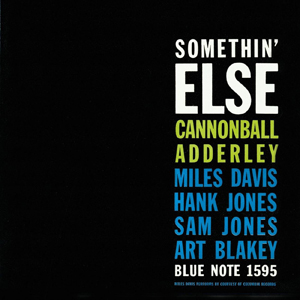
Over the M105’s, all five of the instruments broke free of the speakers. Take the opening song, “Autumn Leaves” for example. The liner notes say Blakey’s cymbals are “discreet and tasteful”. This was my thought exactly, but the real story here was the air and ease of the Revel tweeters in communicating this quality.
The M105’s are small speakers and they clearly won’t have the world’s greatest bass extension, but the bass was certainly satisfying within its abilities. This was heard when things started cooking on “Love for Sale”. Sam Jones’ bass was reproduced spryly. Each solo on this song came through with a scrupulous realism. The M105’s were pulling the trick where I felt as if I were in the studio during one of the greatest jam sessions of all time! On side 2, “Somethin’ Else” just soared on the M105’s with Davis’ trumpet and Addeley’s sax taking charge in a point/counter-point exchange of high order jazz stylings. Amazing.

To my ears, restricted bass extension is actually more of a concern for certain orchestral works than it is for jazz or rock. I think this is because the low bass carries audible cues to the reverberant nature of a large hall. This became apparent when I tried my Dacapo SACD of Danish Romantic Violin Concertos. This album captures soloist Christina Åstrand as she performs works by Niels Gade, Peter Erasmus Lange-Müller and Rued Langgaard. She is backed by the Tampere Philharmonic Orchestra in the Tampere Concert Hall in Finland. I listened to this SACD without the sub.
The M105’s bass rolls off below 60Hz and this limited the speakers’ ability to define the hall’s extents. The performance remained entertaining but on a disproportionately reduced scale. So I got a closer and more up-front perspective than my reference speakers but with contextually appropriate instrumental placement. On the plus side, I did not hear any of the ragged, flabby sound of cone breakup that I am accustomed to hearing with lesser speakers. When it comes to recordings of large orchestras in big halls, I recommend a quality subwoofer with the M105’s.
Elsewhere in the audible spectrum, the M105’s really shone. I just loved their faithful, low distortion reproduction of the lead violin. These speakers also passed the subtlest inflections in Åstrand’s performance. It is in these little details where the life of a recording is brought out.
There was lots of musical energy all around the crossover frequency on this disc. This was handled by the M105’s as well as any speaker I have ever auditioned. I was a huge love affair with these tweeters around this time. Plus, the blending between both drivers was first rate.

I was finding that the M105’s were highly communicative little speakers. They were able to differentiate all sorts of subtleties on recordings. This was apparent on the Blu-ray of Joe Bonamassa “Live from the Royal Albert Hall”.
There were two drum kits on stage and the Performa3’s made it so easy to differentiate them despite that they were closely in time together at various points throughout the performance. Eric Clapton joins Bonamassa on stage and I was able to hear all the tonal differences between Bonamassa’s Les Paul versus Clapton’s Strat.
I decided to crank it up a little on “So Many Roads”. This track really filled my room from corner to corner. This is where the dynamic prowess of these speakers really shone. There was no audible compression even at near live levels. This was an incredible performance for such small speakers in a big room. I got goosebumps!
Bass runs were tuneful throughout but sounded congested due to being overly weighty on the disc. But the guitar sounds drew me in. It was the tweeters again – communicative, airy and not one bit edgy or aggressive. Later Joe’s acoustic guitar sounded as natural as I’ve been able to conjure in my room considering the recording venue and the 48 kHz sampling rate on the stereo track. This was quite impressive.

Believe it or not, the M105’s were maybe even better on cinema. I incorporated my SVS SB13 Ultra sub for movies, crossing it over at 80 Hz. One pretty decent film with amazing audio is “The Hobbit: An Unexpected Journey”. My kids rented this Blu-ray from a Red Box and I decided to write about it because you just can’t beat the music, the effects and the overall audio experience of this Blu-ray.
Revel’s world class design and execution means that the M105’s sorted out this complex audio mix extremely well while their low dynamic compression kept the party going through the heavy action sequences. The M105’s were smooth and composed under fire.
Superior imaging led to an uncanny phantom “center” speaker even though I was listening in stereo. On the musical side, the score had a warmth of tone and a rich structure. There was also a vocal sequence of dwarves singing in harmony early in the movie. The separation in both space and pitch of individual voices was superior over the M105’s. When kept within a manageable output level, the M105’s are a five star performer!
The Revel Performa 3 M105 Bookshelf Speakers On the Bench
All below measurements are in-room response. The frequency response tests were performed at 1-meter, the distortion measurements were on-axis near field measurements with the mic tip precisely 1′ from the driver under test.
The on-axis response of the M105’s shows an exceptionally flat spectrum from 300 Hz to 24 kHz. There are some room-induced fluctuations in the bass below 300 Hz.
At 30 degrees off-axis, the M105’s had a response curve that was nearly as smooth as the on-axis test with surprisingly good treble extension. Again, the unevenness below 300 Hz is due to room effects. This plot confirms the good dispersion characteristics of the M105’s.
The THD at 1 kHz and 100 dB was 0.12%, with the first harmonic 62 db below the test signal.
At 500 Hz and 100 dB, the THD measurement was 0.39%.
The distortion reading rose to 0.44% at 250 Hz and 100 dB.
When I got down to 60 Hz, the distortion would rise quickly as I increased the volume over 90 dB. The above plot shows the 90 dB distortion spectrum which was quite clean with a measured THD of just 0.60%.
At 5 kHz and 100 dB, the measured THD was only 0.09%.
The THD at 10 kHz and 95 dB was also extremely low at just 0.11%. This may partly explain the tweeter-centric love affair I had during my review.
Conclusions about the Revel Performa 3 M105 Bookshelf Speakers
The Revel Performa3 M105’s are a clear expression of recent technical advances from one of the world’s greatest speaker companies. The benefits of this high level of research, development and implementation become obvious when reviewing the battery of bench tests I performed. These speakers have a flat frequency response curve with good dispersion qualities. They had very low distortion readings when kept within their limitations, especially in the treble.
These speakers aren’t just good on the bench, either. In my listening, I found the M105’s incredibly communicative with a smooth, natural frequency balance. They are designed to handle higher SPL’s with little dynamic compression. This meant that the soundstage retained its width while the M105’s offered up one non-fatiguing listening session after another. They also performed well on movies.
I would definitely put these on my short list of speakers to consider if my budget were even as high as $3,000. They are definitely a major contender in their class.







